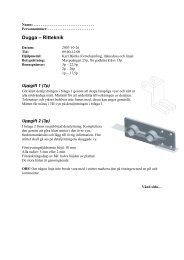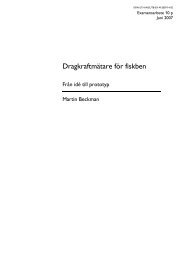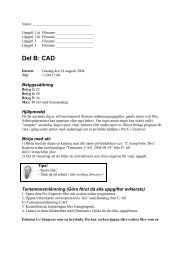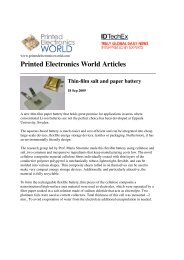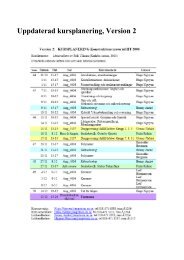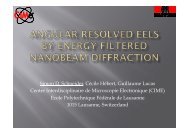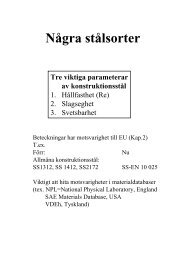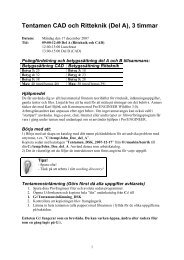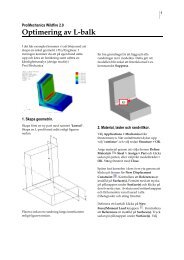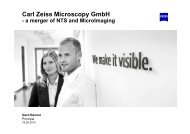Simulating EELS spectra of isolated and coupled metallic ...
Simulating EELS spectra of isolated and coupled metallic ...
Simulating EELS spectra of isolated and coupled metallic ...
You also want an ePaper? Increase the reach of your titles
YUMPU automatically turns print PDFs into web optimized ePapers that Google loves.
<strong>Simulating</strong> <strong>EELS</strong> <strong>spectra</strong> <strong>of</strong> <strong>isolated</strong> <strong>and</strong><br />
<strong>coupled</strong> <strong>metallic</strong> nanoparticles in<br />
the discrete dipole approximation<br />
Stéphane-Olivier Guillaume & Luc Henrard<br />
18-20 June 2012<br />
Uppsala, Sweden
Outline<br />
●<br />
●<br />
●<br />
●<br />
Localized Plasmon Resonance<br />
Optical vs <strong>EELS</strong> experiments<br />
The Discrete Dipole Approximation<br />
Results on gold nanorods<br />
– Isolated<br />
– Size effect<br />
– Substrate effect<br />
– Coupled dimer
Localized Plasmon Resonance<br />
●<br />
●<br />
●<br />
●<br />
Metallic nanoparticles exhibit resonances when<br />
excited by an external electric field<br />
These resonances are called LPR <strong>and</strong> correspond to<br />
collective oscillations <strong>of</strong> conduction electrons<br />
Their properties depend on the size, geometry &<br />
environment <strong>of</strong> the particle<br />
For a sphere with r
Localized Plasmon Resonance<br />
●<br />
At the resonance frequencies<br />
– Intense electric field around the particle<br />
– Very high absorption <strong>and</strong> scattering<br />
●<br />
Can be used for<br />
– Surface Enhanced Raman Spectroscopy<br />
– Phototherapy<br />
– Photovoltaic<br />
– Sensing
Localized Plasmon Resonance<br />
●<br />
Coupling effects for close particles<br />
– Described in terms <strong>of</strong> hybridization <strong>of</strong> individual<br />
modes<br />
– Bright modes have<br />
a non-zero net<br />
dipole moment<br />
– Dark modes have a<br />
vanishing net dipole<br />
moment
Localized Plasmon Resonance<br />
●<br />
Interests <strong>of</strong> <strong>coupled</strong> nanoparticles<br />
– More intense E-field in the gap compared to<br />
<strong>isolated</strong> particles<br />
– Tuning <strong>of</strong> the resonances <strong>spectra</strong>l positions with the<br />
size <strong>of</strong> the gap
Optical vs <strong>EELS</strong> experiments<br />
●<br />
Optical experiments<br />
– Global excitation<br />
– Usually used to measure extinction <strong>spectra</strong><br />
– But light interacts with bright modes only<br />
●<br />
<strong>EELS</strong><br />
– Local excitation<br />
– Allows to probe bright <strong>and</strong> dark modes<br />
– Peak intensities will vary with the impact parameter
The Discrete Dipole Approximation<br />
●<br />
Powerfull method to compute scattering <strong>and</strong><br />
absorption properties <strong>of</strong> particles with arbitray<br />
shapes<br />
● First proposed by Purcell & Pennypacker in 1973<br />
●<br />
Particles are described as a cubic<br />
lattice <strong>of</strong> interacting dipoles
The Discrete Dipole Approximation<br />
●<br />
Having solved for the dipoles, it is possible to<br />
compute measurable quantities<br />
– Extinction<br />
– Loss probability
The Discrete Dipole Approximation<br />
●<br />
●<br />
It is possible to take a semi-infinite substrate into<br />
account with the Method <strong>of</strong> Images<br />
The system to solve is<br />
●<br />
Image dipoles will depend on the orientation <strong>of</strong> the<br />
interface
The Discrete Dipole Approximation<br />
●<br />
A big number <strong>of</strong> dipoles is need for<br />
– Large particles<br />
– Particles with fine details<br />
– Coupled particles<br />
●<br />
●<br />
Becomes ressources dem<strong>and</strong>ing for theses cases<br />
DD<strong>EELS</strong> : homemade code written by N. Geuquet<br />
http://perso.fundp.ac.be/~geuquetn/ddeels.php
Results : <strong>isolated</strong> gold nanorods<br />
●<br />
Geometry<br />
a=10nm<br />
●<br />
d=1nm ⇒ 4000 dipoles<br />
L=400nm<br />
1,81 eV<br />
2,41 eV<br />
1,81 eV<br />
x50<br />
E<br />
k<br />
k<br />
E<br />
2,30 eV<br />
2,41 eV
Results : <strong>isolated</strong> gold nanorods<br />
●<br />
●<br />
●<br />
2 peaks in optics : 1,81 eV <strong>and</strong> 2,41 eV<br />
1 additionnal peak in <strong>EELS</strong> : 2,30 eV<br />
Identify the signature <strong>of</strong> the modes given by the z<br />
component <strong>of</strong> the E-field<br />
Longitudinal<br />
1 st dark mode<br />
Transverse<br />
●<br />
Good agreement with experimental results
Results : <strong>isolated</strong> gold nanorods<br />
●<br />
Size effect at constant aspect ratio<br />
●<br />
●<br />
L=200nm<br />
a=50nm<br />
Same modes<br />
but redshifted<br />
– 0,39 eV<br />
– 0,10 eV<br />
– 0,00 eV<br />
1,42 eV<br />
2,20 eV<br />
2,41 eV
Results : <strong>isolated</strong> gold nanorods<br />
●<br />
●<br />
●<br />
Increased aspect ratio<br />
L=80nm<br />
a=10nm<br />
Same modes<br />
but redshifted<br />
– 0,57 eV<br />
– 0,34 eV<br />
– 0,00 eV<br />
1,24 eV<br />
1,96 eV<br />
2,41 eV
Results : <strong>isolated</strong> gold nanorods<br />
●<br />
Substrate effect<br />
● εsub =2,25<br />
●<br />
Same modes<br />
but redshifted<br />
1,63 eV<br />
– 0,18 eV<br />
– 0,16 eV<br />
– 0,07 eV<br />
2,14 eV<br />
2,35 eV
Results : <strong>coupled</strong> gold nanorods<br />
●<br />
●<br />
2 identical gold nanorods<br />
Transverse coupling<br />
● Longitudinal coupling<br />
g=5nm<br />
g=5nm
Results : <strong>coupled</strong> gold nanorods<br />
●<br />
Longitudinal coupling<br />
E<br />
k k E<br />
x50<br />
●<br />
2 additionnal peaks in <strong>EELS</strong>
Results : <strong>coupled</strong> gold nanorods<br />
●<br />
Modes signature<br />
Bright modes<br />
Dark modes<br />
1,66 eV 1,90 eV<br />
2,41 eV<br />
2,29 eV
Results : <strong>coupled</strong> gold nanorods<br />
●<br />
Transverse coupling<br />
E<br />
k<br />
k<br />
E<br />
x25<br />
●<br />
3 additionnal peaks in <strong>EELS</strong>
Results : <strong>coupled</strong> gold nanorods<br />
● Modes signature<br />
1,96 eV<br />
1,54 eV<br />
2,41 eV<br />
2,17 eV<br />
2,35 eV
Results : <strong>coupled</strong> gold nanorods<br />
●<br />
Gap size effects<br />
Longitudinal coupling<br />
Transverse coupling
Conclusions & perspectives<br />
●<br />
●<br />
We are able to simulate extinction <strong>and</strong> <strong>EELS</strong> <strong>spectra</strong><br />
<strong>of</strong> <strong>metallic</strong> nanoparticles<br />
Some interesting effects<br />
– Size<br />
– Substrate<br />
– Coupling<br />
●<br />
We are developping a code for multiparticle systems<br />
to overcome DDA limitation
Acknowledgement<br />
●<br />
●<br />
●<br />
Luc Henrard<br />
Nicolas Geuquet<br />
Computer ressources<br />
– iSCF<br />
●<br />
Financial support<br />
– F.R.I.A.<br />
●<br />
BTS Team
Thank you for your attention !<br />
Any questions



